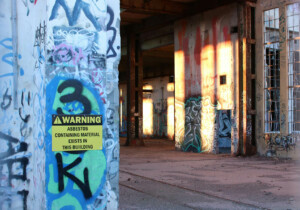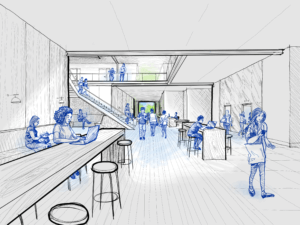While there are scant upsides to the novel coronavirus (COVID-19) crisis, there has been a flurry of speculative solution-oriented design concepts that implore us to think a bit outside of the proverbial box and reconsider how we live, work, play, and interact with the built environment. When this is all behind us, things will likely never quite be the same. These speculative designs, as quixotic as some might seem, give us a glimpse into that altered future where public health and imaginative design are even more closely intertwined.
Below are a few such design proposals to emerge in recent weeks from a range of international firms large and small. All of these concepts tackle unique topics and concerns: A more prudent use of public green space, contagion-safe produce shopping, the adaptive reuse of unorthodox spaces, and working where you live for the long-haul, to name a few. And while some might seem unconventional or outright implausible, these concepts all imagine a world where we are all safe, comfortable, healthy, productive, and able to get the help that we need.
Parc de la Distance, Studio Precht
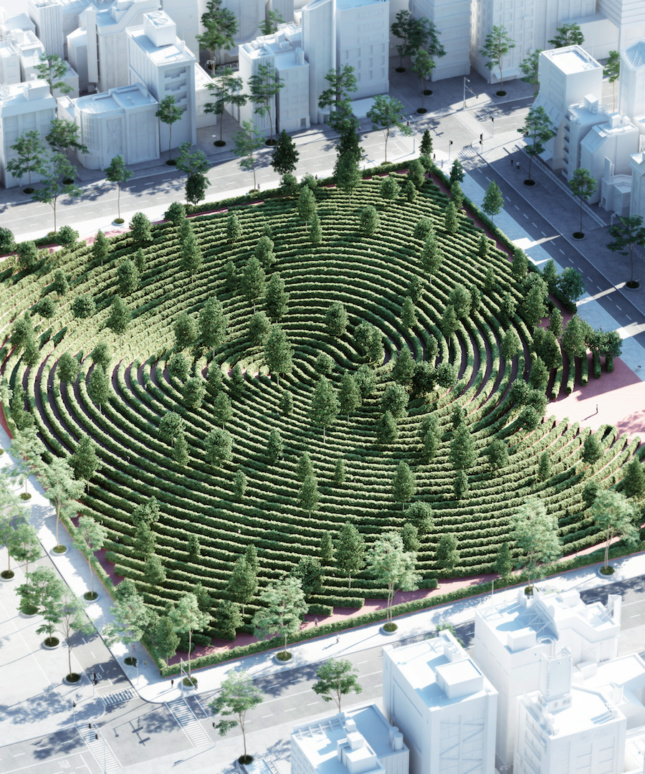
Reminiscent of a particularly panic-inducing hedge maze, Parc de la Distance is more a pandemic-appropriate riff on a Japanese Zen garden, where park-goers would be able to enjoy a contemplative and orderly constitutional without worrying about hordes of fellow fresh air-seekers coming from every which way.
Studio Precht, a small Austrian firm based in a secluded, mountainous area outside of Salzburg, elaborated on the concept, which is geared toward a vacant lot in Vienna but can be replicated on any unused patch of urban land:
“Although our ‘Park de la Distance’ encourages physical distance, the design is shaped by the human touch: a fingerprint. Like a fingerprint, parallel lanes guide visitors through the undulating landscape. Every lane has a gateway on the entrance and exit, which indicates if the path is occupied or free to stroll. The lanes are distanced 240cm [8 foot] from each other and have a 90cm [3 foot] wide hedge as a division. Along their path, people walk on reddish granite gravel. Although people are visually separated most of the time, they might hear footsteps on the pebbles from the neighbouring paths. Each individual journey is about 600m [1,968 foot] long. The height of the planters varies along this journey and gives different levels to the hedges throughout the park. Sometimes visitors are fully immersed by nature, other times they emerge over the hedge and can see across the garden. But at all times, they keep a safe physical distance to each other.”
Studio Precht envisions the concept as being a useful feature for green space-starved cities in the post-COVID era as it “offers something very unique for bustling urban areas: A brief time of solitude. A temporary seclusion from the public. A moment to think, to meditate or just to walk alone through nature.”
Hyperlocal Markets for Shutdown Realities, Shift Architecture Urbanism
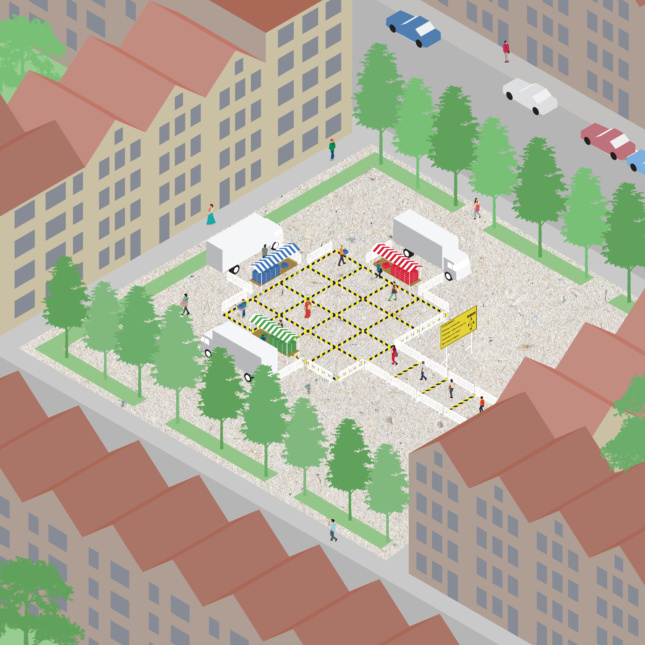
Described by Rotterdam-based studio Shift Architecture Urbanism as a “self-initiated research-by-design project,” the aim of this concept is twofold: To keep fresh, nutritious, and locally grown food flowing into local produce markets while reducing the risk of spreading the virus among shoppers at said markets, which are frequently prone to overcrowding but are also often lower cost than supermarkets in many areas.
“Shift’s proposal is to keep the vital function of the fresh produce markets fully intact, even strengthening it, while at the same time minimizing its potential role in spreading the virus. For this, the large markets have to continue in a different form, place and time. Its former model of concentration has to be replaced by a model of dispersion, both in space and time. This is done by breaking down the large markets into so-called micro markets that are spread over the city and opening them up for a longer time. Instead of you going to the market, the market is coming to your neighborhood. These hyper-local markets are open at least 5 days a week instead of twice a week to further reduce the concentration of people.
“The micro market’s standard spatial setup consists of a 16 square grid, aligned with three market stalls, each selling a different kind of fresh produce such as fruits, vegetables, dairy products or meat. The grid is taped on the pavement and fenced off with standard crush barriers. It has one entrance and 2 exits. In order to maintain social distancing each cell can only hold one person. In order to permit movement, the grid can only hold a maximum of 6 people. These rules are made clear at the entrance of the micro market, that has a waiting line taped on the pavement. The stalls will offer packages instead of separate products, to limit the time customers spend in the grid.”
Shift added that current restrictions on open-air produce markets vary wildly in the Netherlands from location-to-location and region-to-region.
Airport Superhospital, Opposite Office
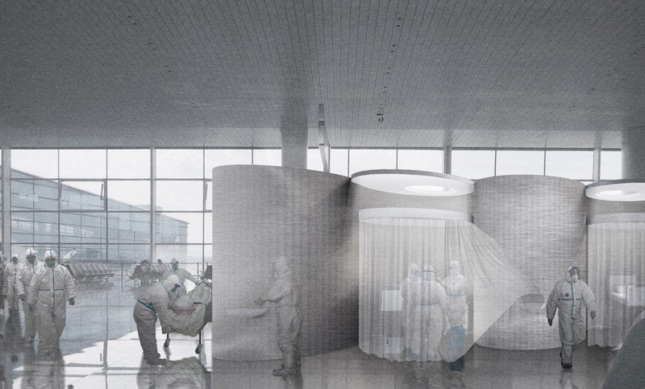
Everything from convention centers to soccer stadiums have been transformed into temporary medical hubs during the coronavirus pandemic. Benedikt Hartl of the Munich-based Opposite Office, the same firm that pitched transforming Buckingham Palace into a co-living complex, envisioned this form of emergency adaptive reuse as also being extended to incomplete airport terminals.
Under construction since 2006 with a potential completion date of 2021, Hartl sees promise in the delay-plagued Berlin Brandenburg Airport—or other underserved and non-operational airports, really—during the crisis (although said crisis in Germany has now largely passed). Hartl’s concept involves populating the uncompleted airport’s vast floor space with round modular steel cabins that serve as self-contained treatment units for patients.
“Flying was no longer in vogue even before the outbreak of COVID-19 and now the avenge of shame has given way to a deadly risk of infection. We agree that we will certainly not need this new airport in the near future,” read a press release from Opposite Office. “An advantage would be that infected people would be completely isolated at the airport area and would not come into contact with other patients. The main building alone, with an area of 220,000m2 [2.4 million square feet], offers plenty of space for medical (emergency) care. The existing airport offers untapped potential.”
Container Ship Hospitals, Weston Williamson + Partners
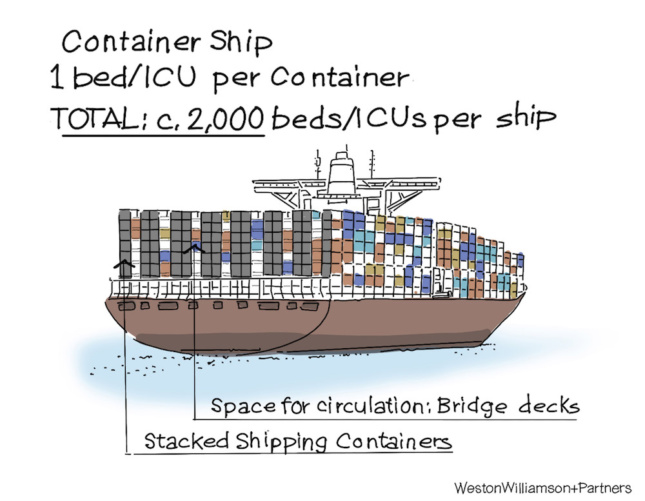
While converting seafaring vessels into floating hospitals is far from something new, a concept from London-headquartered architecture firm Weston Williamson+ Partners proposes the specific repurposing of container ships to serve a similar purpose. Well, kind of. Ideally, the containers would be unloaded at different ports in hard-hit regions and then used as makeshift intensive care units on land. “The idea came to us because we work around the world and wanted to try to encourage a global response,” firm co-founder Chris Williamson told AN in an email of the scheme, which is somewhat similar to an initiative underway in India with modified rail cars. “Many countries do not have an exhibition centre waiting to be fitted out as a hospital as we have done in Manchester and London.”
“The speed at which Excel in London and GMex in Manchester have been repurposed suggest that the idea is possible and the container module is ideal for an intensive care bed and equipment for the benefit of emerging economies,” Willamson elaborated. “We have ascertained from the shipping companies that there is an available capacity of around 1,000 ships with around 3,500 containers per vessel.”
Williams goes on to make clear that “patients would not stay on the ship except in circumstances where there is no place to deploy the containers” and that the container-based care units would have one of the steel doors removed and a transparent Perspex door installed in its place. The modules would also include built-in air conditioning units. “All we need is the political will to make this work and we are working with a few influential people to that aim,” Williamson said.
It should be noted that, as with many shipping container-based projects, the feedback online hasn’t been entirely positive.
Mobile PPS (Personal Protective Space), Plastique Fantastique
Plastique Fantastique, a Berlin-founded art collective known for eye-popping inflated installations, has created a PPS (personal protective space) for healthcare workers that can be swiftly deployed to a wide array of environments. As Plastique Fantastique explained, this “pneumatic space where doctors can treat patients in transparent protective space. It has constant overpressure, which means, the air flows only toward [the] outside of the space, not letting the virus coming inside. The clean air supply is guaranteed by a ventilator located outside or in an extra decontaminated space.”
The bubbly blow-up Care Units, made from transparent polyurethane, can be attached to each to form larger contiguous spaces, and are accessed through special airlock chambers that maintain air pressure and provides medical workers with a space to prepare and disinfect before entering.
AD-APT, Woods Bagot
With offices shuttered across the globe and workforces now operating in domestic trappings without any clear end in sight, global architecture firm Woods Bagot has envisioned a super-versatile living modular system dubbed AD-APT that “supports a range of activities throughout people’s days” while more easily accommodating “spaces for exercise, entertainment, digital collaboration, connection, and focus (without becoming isolated), alongside the traditional activities of eating, sleeping, and washing.”
“While this trend has been on the rise over recent years the immediate, en masse shift to WFH exposes the benefits (and challenges) to a far wider range of the population than ever before,” explained the firm. “This will lead to significant change in people’s work habits and expectations. As more people become comfortable with working remotely, they will expect to be able to do so more often. This will change the way we design and use our workplaces, schools, and homes.”
In response to this quickly changing dynamic, AD-APT enables WFH-ers to modify open-plan apartments to suit their needs whether they’re in a so-called “split-shift” residence where working parents tag-team childcare responsibilities and job-related tasks or a “double desk” living environment where roommates rotate to different work-friendly spaces throughout the day.
“Creating a spine of the fixed needs of a home (bathroom, entry, storage etc.) allows us to create an open and flexible apartment that can adapt to varying needs across modes, ” elaborated Woods Bagot. “The AD-APT includes a range of consistent elements which support the mode switching of the main spaces. AD-APT includes an entry porch which provides both an opportunity to meet and stay in touch with your neighbours and additional storage for bikes, coats and shoes. Beyond the entry porch the spine includes a bathroom and two flexi-booths. Around the entire apartment extensive storage is provided to allow for filing/appliance and other materials needed to blend living, working, and learning.”








